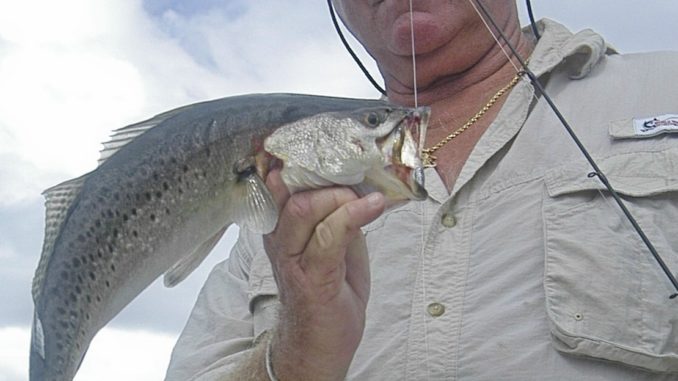
Spotted sea trout (aka, speckled trout) are completely off the charts now in many rivers and feeder creeks inshore at North Carolina’s central coast, but most of them are smaller specimens.
However, that’s not altogether bad news.
“What this means is the hard freeze of last January didn’t affect the specks nearly as much as we thought,” said Mark Hoff, owner of Sweeter Charters (252-717-4521) guide service of Oriental. “And that means we should have an excellent summer next (2011) year.”
Anglers are catching hundreds of specks less than 14-inch keeper size in the Neuse, Pamlico and Pungo rivers and around Swan Quarter, he said.
“We’ve got a very nice year class of 1-year-old specks,” Hoff said. “The hot tickets are popping corks (as lure rigs); they’re mostly being used by people who can’t detect a bite on (artificial) lures. They’re using 1/8- to 1/4-ounce jigheads tipped with curlytail grubs, Gulp! shrimp and paddletail shrimp. Any (soft-plastic trailer) in white or something with green in it is getting bit hard.
“But you might have to catch five to 15 under the 14-inch (keeper) limit before you’ll catch a nice one. People who are willing to throw hard baits (MR17 MirrOlures and Yo-Zuri Crystal Minnows) until their arms fall off are catching fish from 4 to 6 pounds, people who are willing to look for bigger fish.”
With a plethora of smaller fish, Hoff said he urges his clients to pinch down the barbs of hooks and shake trout off when they catch them to avoid touching fish.
“If you grab a trout and knock off just a little bit of slim (from a fish’s body), it’ll die three or four days later, so I ask my clients to grab the grub and shake the fish off without touching it,” he said.
Red drum remain tight to the banks in the main part of the Neuse River, Hoff said, and haven’t yet moved into the creeks in great numbers.
“Just look for bait being busted on the surface; a school of reds is usually right behind them,” he said.
Anglers are using a combination of live bait and artificial lures to catch redfish.
“A miniature Owen Lupton with a small live menhaden and pinched-down hook works well because there are still a lot of menhaden in the water,” Hoff said.
Artificial-lure fans are casting Gulp! Shrimp on 1/4-ounce jigheads.
“You have to cast right to the edge of the grass and you’ll only be able to pop the lure (off the bottom) a couple times until it’s 5 feet or so off the grass and out of the strike zone,” Hoff said. ‘It’s kind of like golf; you don’t always hit the sweet spot every swing, so it takes some time to catch reds this way unless you’re an excellent caster.’
Sizes of the reds are ranging from 24 to 30 inches in length.
“A lot of the older fish are migrating (to the ocean), but there’s always the possibility of running into one of the bigger ones who decided to stay (in the river),” he said.
Striped bass also are beginning to attack topwater lures near New Bern.
“I expect striper fishing up there to get better and better until it peaks in November and December,” Hoff said.


